🌶️1.死锁
1.1 死锁的定义
死锁,是指多个线程或者进程在运行过程中因争夺资源而造成的一种僵局,当进程或者线程处于这种僵持状态,若无外力作用,它们将无法再向前推进。
如下图所示,以申请锁资源为例。线程 A 想申请线程 B 的锁,线程 B 想申请线程 C 的锁,线程 C 想申请线程 D 的锁,线程 D 想申请线程 A 的锁,从而构建了一个资源申请环。
 多个线程之间依次想要访问其他线程的资源,这样相互僵持形成的一个资源申请闭环。 死锁的存在是因为有资源申请环的存在,所以只要能检测出资源申请环,就等同于检测出 死锁的存在。
多个线程之间依次想要访问其他线程的资源,这样相互僵持形成的一个资源申请闭环。 死锁的存在是因为有资源申请环的存在,所以只要能检测出资源申请环,就等同于检测出 死锁的存在。
1.2 死锁产生的条件
1.条件互斥:进程/线程要求对所分配的资源进行排它性控制,即在一段时间内某资源仅为一进程/线程所占用。 2.请求与保持:当进程/线程因请求资源而阻塞时,对已获得的资源保持不放。 3.不剥夺:进程/线程已获得的资源在未使用完之前,不能剥夺,只能在使用完时由自己释放。 4.环路等待:在发生死锁时,必然存在一个进程/线程——资源的环形链。
🍑2. 死锁检测
为了能检测系统是否发生死锁,需要有两点
用某种数据结构来保存资源的请求和分配信息;
提供一种算法,利用上述信息检测系统是否进入死锁状态。
2.1 资源分配图
在资源分配图中,有两个节点,两种边 1)两种结点
进程结点:对应一个进程
资源结点:对应一类资源,资源可能有多个
2)两种边
进程结点 ——> 资源结点:表示进程想申请几个资源(每条边代表一个)
资源结点 ——> 进程结点:表示已经为进程分配了几个资源(每条边代表一个)
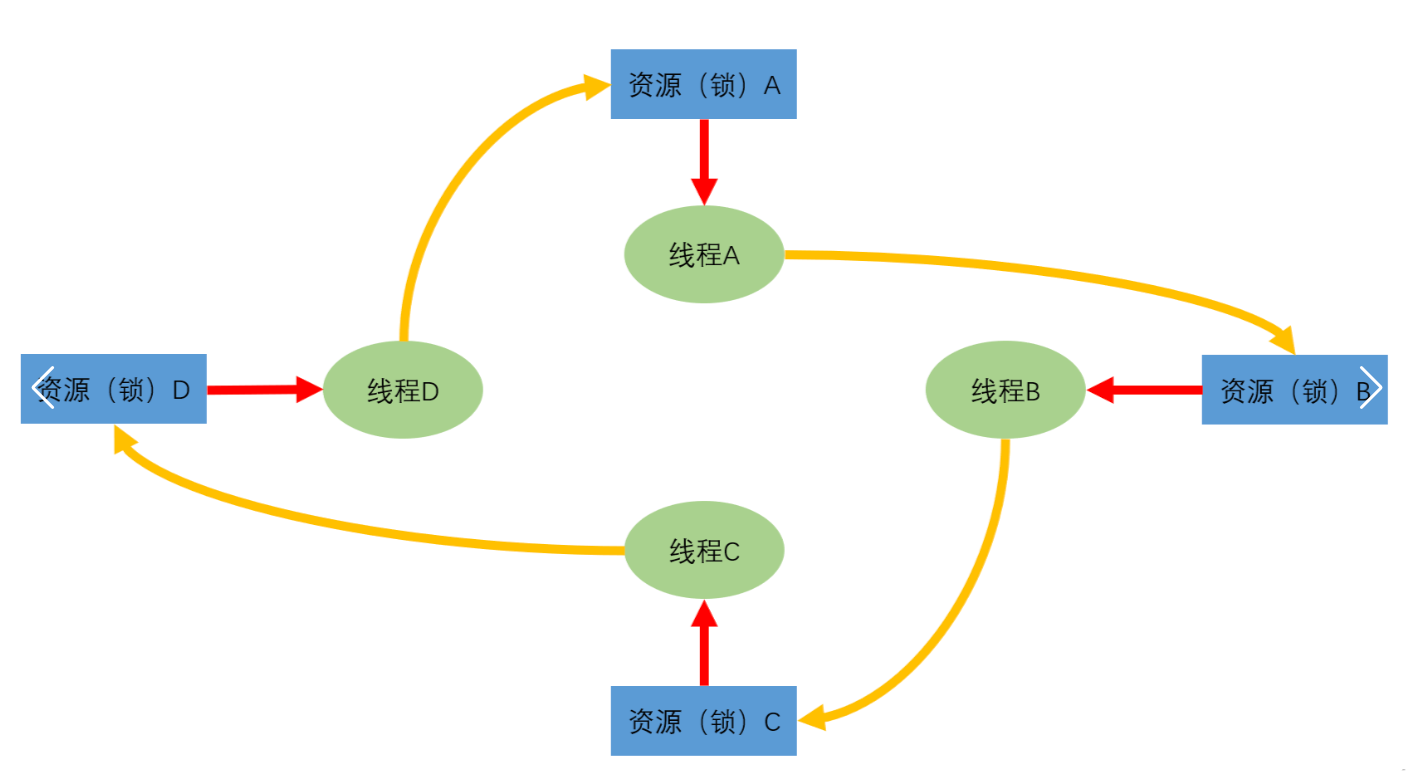 如图,顶点表示进程;黄色边代表资源申请边;红色边代表资源获取边。 每个进程获取了自己的资源(锁),同时又申请了其他线程的资源(锁)。
如图,顶点表示进程;黄色边代表资源申请边;红色边代表资源获取边。 每个进程获取了自己的资源(锁),同时又申请了其他线程的资源(锁)。
上图展示了一个死锁,检测死锁的关键是检测资源申请边有没有构成一回路。
我们可以采用有向图来存储资源申请环,则问题转化为检测有向图是否成环。
2.2 有向图
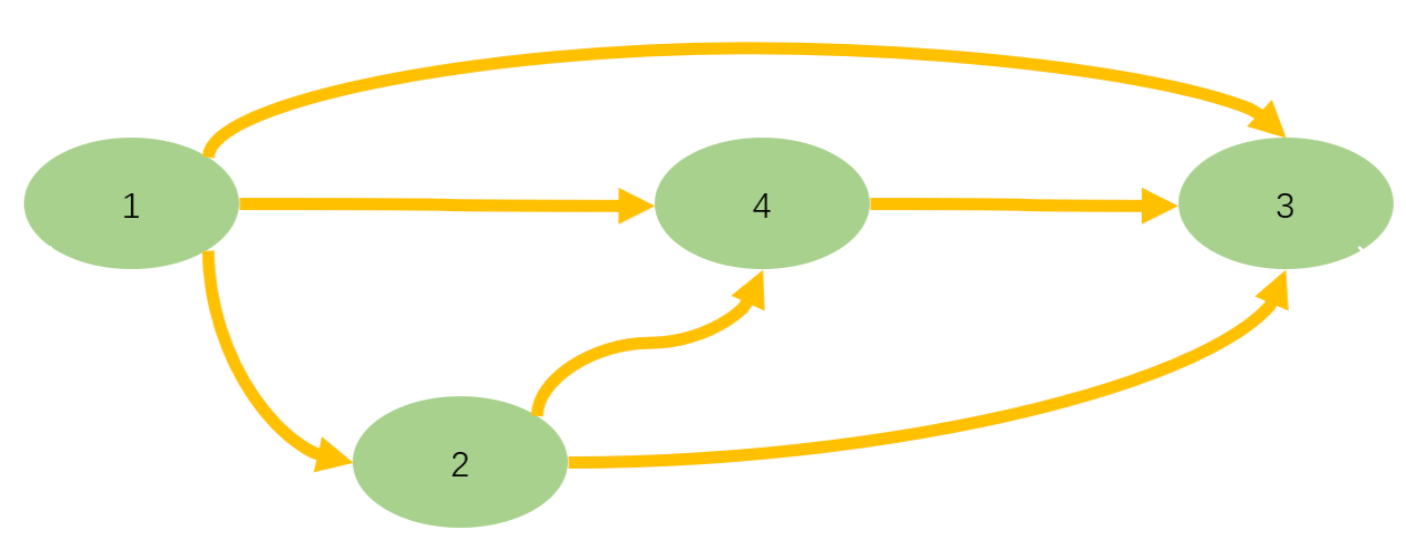 其邻接表
其邻接表
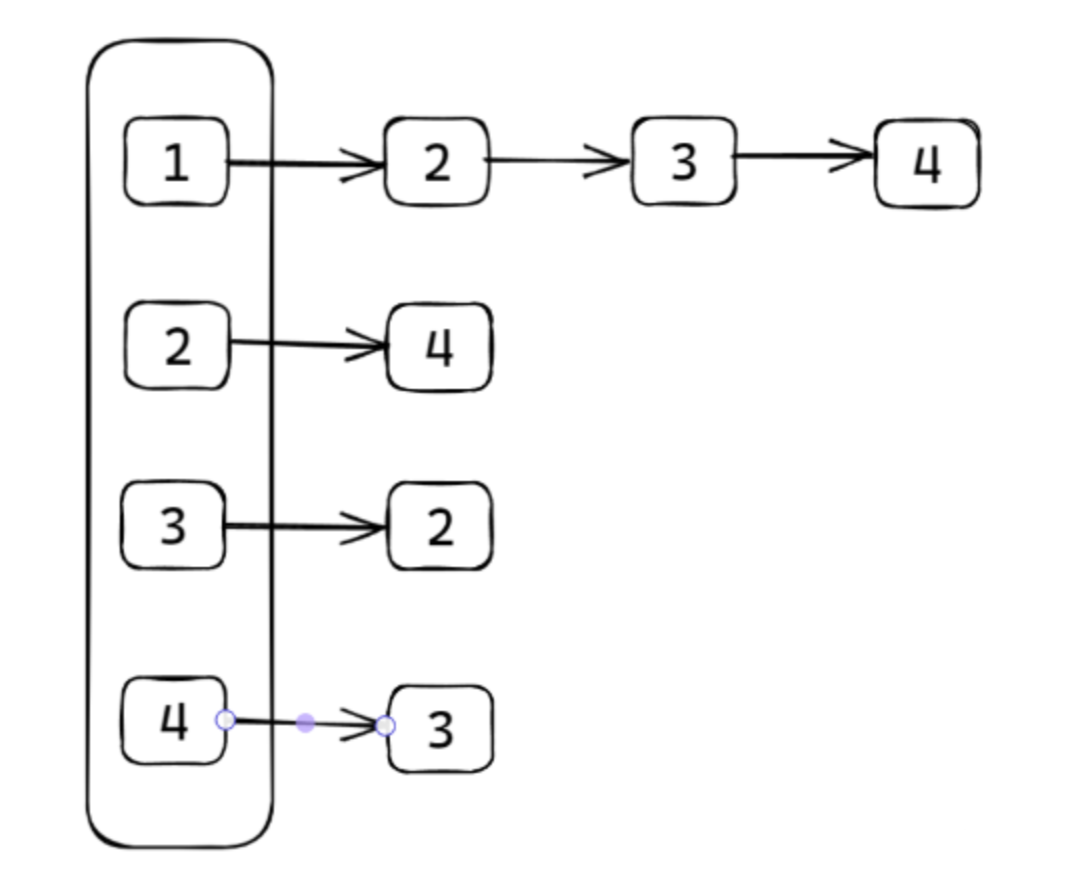
2.3 死锁检测组件- hook
死锁检测的流程可大致归纳为: 1)hook拦截系统的锁接口(pthread_mutex_lock和pthread_mutex_unlock); 2)在hook后的锁接口中,利用有向图存储资源分配图的信息 线程A申请线程B的资源锁:若锁未被占有,则占有这个锁;若锁被占有,构建线程A指向线程B的申请边。 3)创建一个线程,定时检测图进程是否有环的存在。
hook类似于C++中的重载。通过hook,系统的pthread_mutex_lock和pthread_mutex_unlock,将指向我们自己定义的函数。
hook重载的函数中,把线程与锁的申请关系构建成有向图。通过线程加锁前、加锁后、释放锁,这3个阶段维护有向图 1)加锁前:检测当前申请的锁是否被占用
若被占用:构建当前线程指向占有锁的线程之间的申请边
若未被占用:继续执行后续(占有这个锁) 2)加锁后:占有这个锁之后,检测
该锁在之前没有被占有过:建立线程id与锁id的对应关系
该锁在之前被占有过:释放之前创建的申请边,建立线程id与锁id的对应关系
该锁在之前没被占有过:建立线程id与锁id的对应关系 3)释放锁:清除锁与线程的对应关系
🍇 3. 死锁设计
3.1 有向图
3.1.1 数据结构
线程既可以拥有资源,也可以申请资源,资源绑定线程。为了实现复用,增加了 type 字段,当 type = RESOURCE,该结构体作为资源使用,放入资源链表; type = PROCESS,该结构体作为线程使用。
1)顶点资源信息,即线程所拥有的资源信息
// 顶点资源信息
struct source_type {
uint64 id; // 拥有该资源的线程 id
enum Type type; // 顶点类型:线程 or 资源
uint64 lock_id; // 资源(锁) id
int degress; // 资源的出度,该资源被多少顶点(线程)申请
};
2)顶点,表示线程;图的资源申请边,表示线程间的资源申请关系。
// 顶点信息
struct vertex {
struct source_type s; // 顶点资源信息
struct vertex *next; // 指向下一个顶点(邻接表)
};3)图的结构,资源 (type = RESOURCE) 存储在资源链表,线程(type = PROCESS) 作为图上的顶点。
// 图结构
struct task_graph {
struct vertex list[MAX]; // 存储顶点于数组中
int num; // 顶点的数量
struct source_type locklist[MAX]; // 存储所有顶点资源(锁)
int lockidx; // 资源(锁)的数量
pthread_mutex_t mutex;
};3.1.2 图的基本操作接口
创建顶点:create_vertex(struct source_type type)
增加顶点:add_vertex(struct source_type type)
寻找与资源对应的顶点所在的下标:search_vertex(struct source_type type)
增加一条资源申请边:add_edge(struct source_type from, struct source_type to)
检查资源i和j之间是否存在边:verify_edge(struct source_type i, struct source_type j)
删除资源from到to之间的边:remove_edge(struct source_type from, struct source_type to)
// 创建结点
struct vertex *create_vertex(struct source_type type) {
struct vertex *tex = (struct vertex *)malloc(sizeof(struct vertex ));
tex->s = type;
tex->next = NULL;
return tex;
}
// 寻找与资源对应的顶点所在的下标
int search_vertex(struct source_type type) {
int i = 0;
for (i = 0;i < tg->num;i ++) {
if (tg->list[i].s.type == type.type && tg->list[i].s.id == type.id) {
return i;
}
}
return -1;
}
// 增加节点
void add_vertex(struct source_type type) {
if (search_vertex(type) == -1) {
tg->list[tg->num].s = type;
tg->list[tg->num].next = NULL;
tg->num ++;
}
}
// 增加一条边
int add_edge(struct source_type from, struct source_type to) {
add_vertex(from);
add_vertex(to);
struct vertex *v = &(tg->list[search_vertex(from)]);
while (v->next != NULL) {
v = v->next;
}
v->next = create_vertex(to);
}
// 检查资源i和j之间是否存在边
int verify_edge(struct source_type i, struct source_type j) {
if (tg->num == 0) return 0;
// 寻找资源i对应的结点下标
int idx = search_vertex(i);
if (idx == -1) {
return 0;
}
struct vertex *v = &(tg->list[idx]);
while (v != NULL) {
if (v->s.id == j.id) return 1;
v = v->next;
}
return 0;
}
// 删除资源from到to之间的边
int remove_edge(struct source_type from, struct source_type to) {
int idxi = search_vertex(from);
int idxj = search_vertex(to);
if (idxi != -1 && idxj != -1) {
struct vertex *v = &tg->list[idxi];
struct vertex *remove;
while (v->next != NULL) {
if (v->next->s.id == to.id) {
remove = v->next;
v->next = v->next->next;
free(remove);
break;
}
v = v->next;
}
}
}3.1.3 判断有向图是否成环
// 打印环 cycle : 1 --> 2 --> 3 --> 4 --> 2
void print_deadlock(void) {
int i = 0;
printf("cycle : ");
for (i = 0;i < k-1;i ++) {
printf("%ld --> ", tg->list[path[i]].s.id);
}
printf("%ld\n", tg->list[path[i]].s.id);
}
int DFS(int idx) {
struct vertex *ver = &tg->list[idx];
// 如果当前结点已经访问过,说明存在环
if (visited[idx] == 1) {
path[k++] = idx;
print_deadlock();
deadlock = 1;
return 0;
}
// 否则将标记置为1,代表访问了,继续DFS
visited[idx] = 1;
path[k++] = idx;
while (ver->next != NULL) {
DFS(search_vertex(ver->next->s));
k --;
ver = ver->next;
}
return 1;
}
//从list[idx]的顶点开始,检测是否存在环
int search_for_cycle(int idx) {
struct vertex *ver = &tg->list[idx];
visited[idx] = 1; // 标记idx处顶点被访问过
k = 0;
path[k++] = idx; // 记录起点
while (ver->next != NULL) {
// 把visited数组的开始到idx-1处的值都置为0
int i = 0;
for (i = 0;i < tg->num;i ++) {
if (i == idx) continue;
visited[i] = 0;
}
// 把path数组的第i到MAX处的值都置为-1
for (i = 1;i <= MAX;i ++) {
path[i] = -1;
}
k = 1;
DFS(search_vertex(ver->next->s));
ver = ver->next;
}
}
3.2 hook
3.2.1 重载系统的锁接口
// ·······································hook··············································
// 1.定义原类型
typedef int (*pthread_mutex_lock_t)(pthread_mutex_t *mutex);
pthread_mutex_lock_t pthread_mutex_lock_f = NULL;
typedef int (*pthread_mutex_unlock_t)(pthread_mutex_t *mutex);
pthread_mutex_unlock_t pthread_mutex_unlock_f = NULL;
// 2.实现
int pthread_mutex_lock(pthread_mutex_t *mutex) {
pthread_t selfid = pthread_self();
// 获取锁之前,检测这个锁是否被占用。
// 有的话就创建资源申请边,没有的话就跳过
lock_before((uint64_t)selfid, (uint64_t)mutex);
pthread_mutex_lock_f(mutex);
// 获取锁之后,检测这个锁是否存在与资源列表中。
// 存在的话,移除自己对这个锁的申请边,表示请求得到满足了;不存在的话,把这个锁加入资源列表中。
lock_after((uint64_t)selfid, (uint64_t)mutex);
}
int pthread_mutex_unlock(pthread_mutex_t *mutex) {
pthread_mutex_unlock_f(mutex);
pthread_t selfid = pthread_self();
unlock_after((uint64_t)selfid, (uint64_t)mutex);
}
// 3. 初始化
void init_hook(void) {
if (!pthread_mutex_lock_f)
pthread_mutex_lock_f = dlsym(RTLD_NEXT, "pthread_mutex_lock");
if (!pthread_mutex_unlock_f)
pthread_mutex_unlock_f = dlsym(RTLD_NEXT, "pthread_mutex_unlock");
}3.2.2 加锁前——lock_before
获取资源(锁)前,检测该资源是否被其他线程占用。
如果被占用,则创建一条资源申请边,表示当前进程正在向拥有资源的线程申请该资源。
如果没有被占用,则跳过。
void lock_before(uint64_t tid, uint64_t lockaddr) {
/*
1. if (lockaddr) {
tid --> lockaddr.tid;
}
*/
int idx = 0;
for (idx = 0;idx < tg->lockidx;idx ++) {
// 1. 如果被占用
if (tg->locklist[idx].lock_id == lockaddr) {
// 创建申请该资源的顶点(PROCESS类型)
struct source_type from;
from.id = tid;
from.type = PROCESS;
add_vertex(from);
// 创建拥有该资源的顶点(PROCESS类型)
struct source_type to;
to.id = tg->locklist[idx].id;
to.type = PROCESS;
add_vertex(to);
// 申请该资源的结点数量+1
tg->locklist[idx].degress ++;
// 如果两个顶点间不存在资源申请边,增加一条边
if (!verify_edge(from, to))
add_edge(from, to);
}
}
}3.2.3 加锁后——lock_after
线程获取资源(锁)后,检查该资源是否存在(资源链表中是否存在)
若该资源之前不存在,添加资源到资源链表中
若该资源已经存在,则移除之前创建的自己对该资源的申请边,表示请求已经得到满足
void lock_after(uint64_t tid, uint64_t lockaddr) {
/*
if (!lockaddr) {
tid --> lockaddr;
} else {
lockaddr.tid = tid;
tid -> lockaddr;
}
*/
int idx = 0;
// 1. 若该资源(锁)不存在,添加资源到资源链表中
if (-1 == (idx = search_lock(lockaddr))) {//
// 寻找资源链表中空闲的位置并添加该资源
int eidx = search_empty_lock(lockaddr);
tg->locklist[eidx].id = tid;
tg->locklist[eidx].lock_id = lockaddr;
// 资源数量+1
tg->lockidx ++;
}
else { // 2. 该资源(锁)存在,需要移除自己的请求边
// 申请该资源的顶点(PROCESS类型)
struct source_type from;
from.id = tid;
from.type = PROCESS;
add_vertex(from);
// 拥有该资源的顶点(PROCESS类型)
struct source_type to;
to.id = tg->locklist[idx].id;
to.type = PROCESS;
add_vertex(to);
// 申请该资源的顶点数-1
tg->locklist[idx].degress --;
// 如果存在该资源申请边,则删除
if (verify_edge(from, to))
remove_edge(from, to);
// 线程占用该资源(锁)
tg->locklist[idx].id = tid;
}
}
3.2.4 解锁后——unlock_after
线程释放该资源后,检查该资源是否还被其他线程申请,没有则将其从资源链表中移除。
void unlock_after(uint64_t tid, uint64_t lockaddr) {
// lockaddr.tid = 0;
// 此锁已被unlock
int idx = search_lock(lockaddr);
// 若该资源没有线程申请,则将其从资源链表中移除
if (tg->locklist[idx].degress == 0) {
tg->locklist[idx].id = 0;
tg->locklist[idx].lock_id = 0;
}
}3.3 死锁检测线程
创建死锁检测线程,在程序的运行期间时刻监控线程和锁之间的关系
// 检测死锁
void check_dead_lock(void) {
int i = 0;
deadlock = 0;
for (i = 0;i < tg->num;i ++) {
if (deadlock == 1) break;
// 检测是否存在环,即死锁
search_for_cycle(i);
}
if (deadlock == 0) {
printf("no deadlock\n");
}
}
// 检测死锁的线程
static void *thread_routine(void *args) {
while (1) {
sleep(5); //每隔5秒检测一次
check_dead_lock();
}
}
// 开启死锁检测
void start_check(void) {
tg = (struct task_graph*)malloc(sizeof(struct task_graph));
tg->num = 0;
tg->lockidx = 0;
pthread_t tid;
// 创建检测死锁的线程
pthread_create(&tid, NULL, thread_routine, NULL);
}3.4 画图解释
1.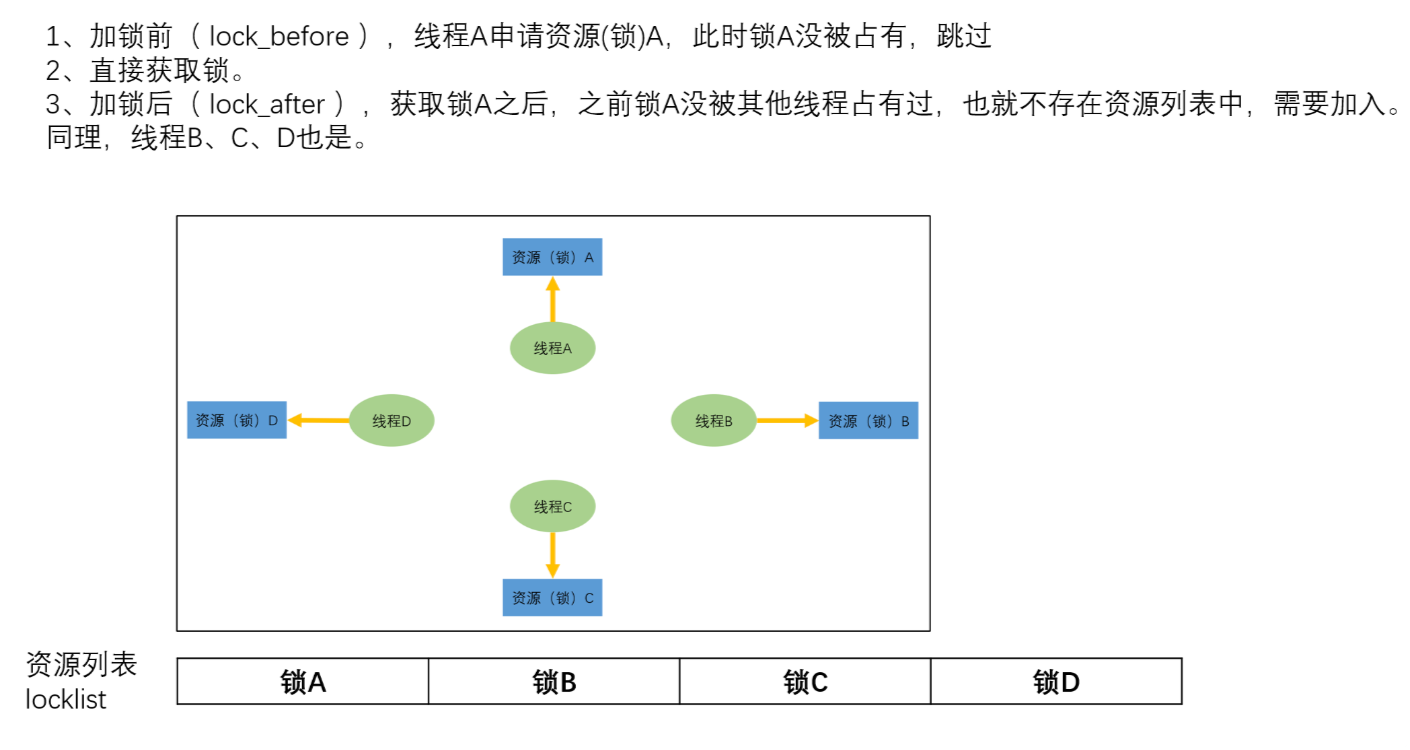
2.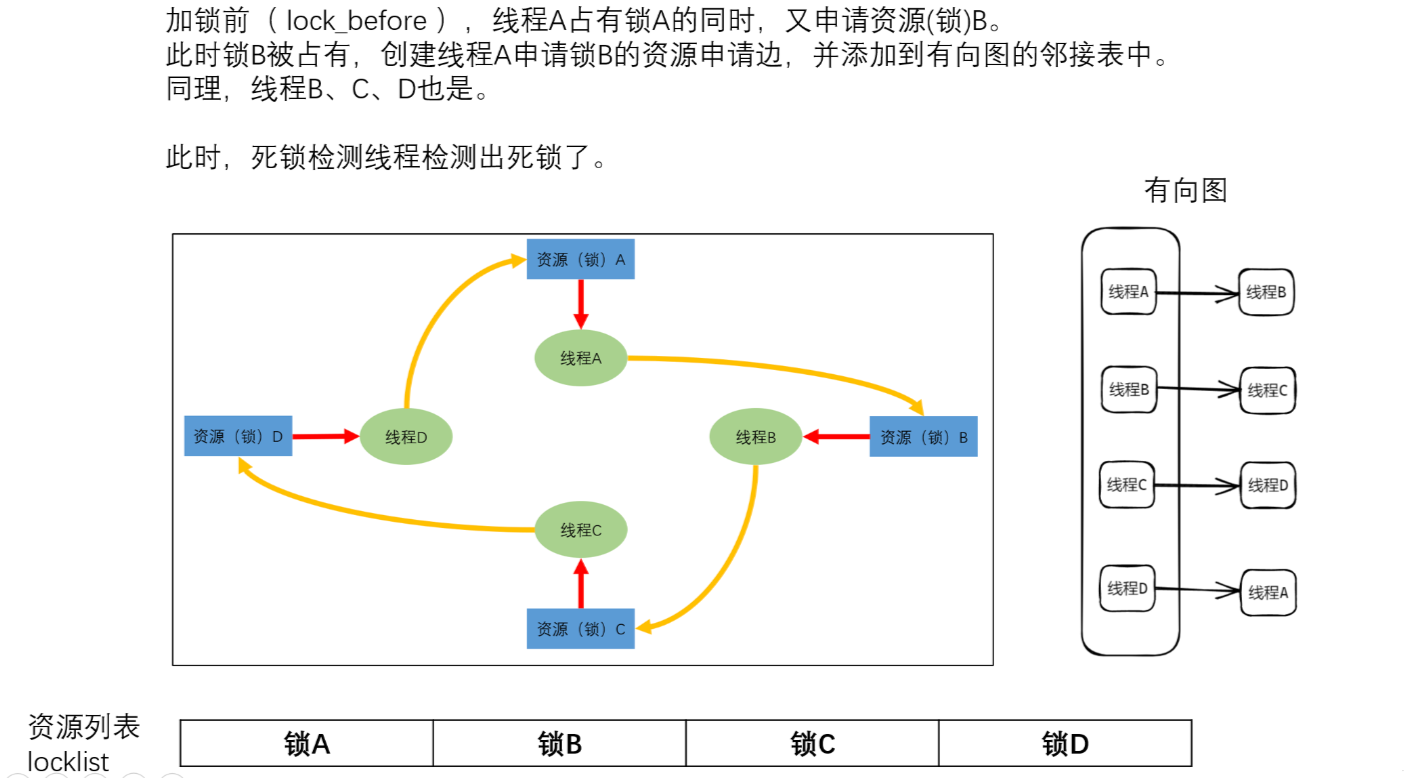
3.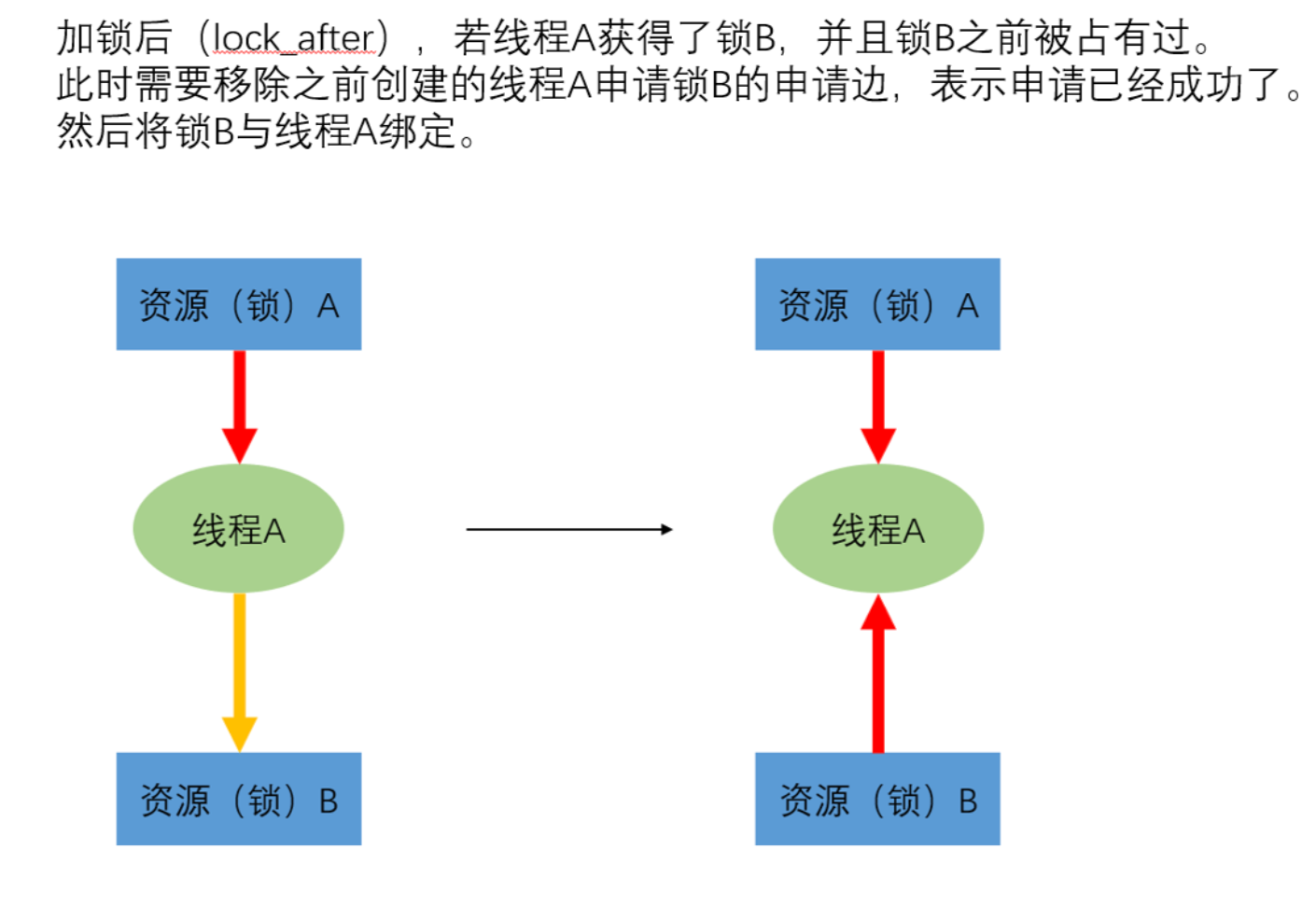
🍐4. 代码实现及测试
创建5个线程,1申请2、2申请3、3申请4、4申请5、5申请1 出现死锁 
修改1申请2、2申请3、3申请4、4申请5 检测完成,未出现死锁 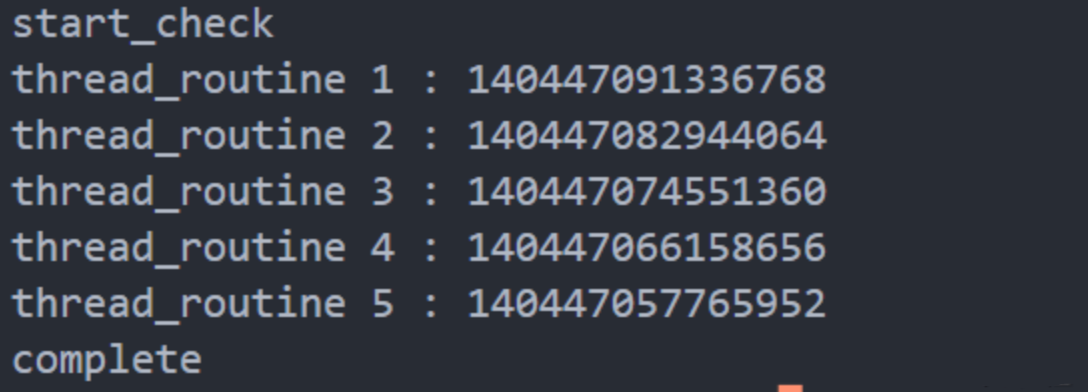
// build: gcc -o deadlock deadlock.c -lpthread -ldl
#define _GNU_SOURCE
#include <dlfcn.h>
#include <stdio.h>
#include <stdlib.h>
#include <pthread.h>
#include <unistd.h>
#include <stdint.h>
//·········································有向图的结构和基本操作接口····························································
#if 1 // 图结构
typedef unsigned long int uint64;
#define MAX 100
enum Type {PROCESS, RESOURCE};
// 顶点资源信息
struct source_type {
uint64 id; // 拥有该资源的线程 id
enum Type type; // 顶点类型:线程 or 资源
uint64 lock_id; // 资源(锁) id
int degress; // 资源的出度,该资源被多少顶点(线程)申请
};
// 顶点信息
struct vertex {
struct source_type s; // 顶点资源信息
struct vertex *next; // 指向下一个顶点(邻接表)
};
// 图结构
struct task_graph {
struct vertex list[MAX]; // 存储顶点于数组中
int num; // 顶点的数量
struct source_type locklist[MAX]; // 存储所有顶点资源(锁)
int lockidx; // 资源(锁)的数量
pthread_mutex_t mutex;
};
struct task_graph *tg = NULL;
int path[MAX+1];
int visited[MAX];
int k = 0;
int deadlock = 0; // 死锁标记
// 创建顶点
struct vertex *create_vertex(struct source_type type) {
struct vertex *tex = (struct vertex *)malloc(sizeof(struct vertex ));
tex->s = type;
tex->next = NULL;
return tex;
}
// 寻找与资源对应的顶点所在的下标
int search_vertex(struct source_type type) {
int i = 0;
for (i = 0;i < tg->num;i ++) {
if (tg->list[i].s.type == type.type && tg->list[i].s.id == type.id) {
return i;
}
}
return -1;
}
// 增加节点
void add_vertex(struct source_type type) {
if (search_vertex(type) == -1) {
tg->list[tg->num].s = type;
tg->list[tg->num].next = NULL;
tg->num ++;
}
}
// 增加一条边
int add_edge(struct source_type from, struct source_type to) {
add_vertex(from);
add_vertex(to);
struct vertex *v = &(tg->list[search_vertex(from)]);
while (v->next != NULL) {
v = v->next;
}
v->next = create_vertex(to);
}
// 检查资源i和j之间是否存在边
int verify_edge(struct source_type i, struct source_type j) {
if (tg->num == 0) return 0;
// 寻找资源i对应的结点下标
int idx = search_vertex(i);
if (idx == -1) {
return 0;
}
struct vertex *v = &(tg->list[idx]);
while (v != NULL) {
if (v->s.id == j.id) return 1;
v = v->next;
}
return 0;
}
// 删除资源from到to之间的边
int remove_edge(struct source_type from, struct source_type to) {
int idxi = search_vertex(from);
int idxj = search_vertex(to);
if (idxi != -1 && idxj != -1) {
struct vertex *v = &tg->list[idxi];
struct vertex *remove;
while (v->next != NULL) {
if (v->next->s.id == to.id) {
remove = v->next;
v->next = v->next->next;
free(remove);
break;
}
v = v->next;
}
}
}
// 打印环 cycle : 1 --> 2 --> 3 --> 4 --> 2
void print_deadlock(void) {
int i = 0;
printf("deadlock : ");
for (i = 0;i < k-1;i ++) {
printf("%ld --> ", tg->list[path[i]].s.id);
}
printf("%ld\n", tg->list[path[i]].s.id);
}
int DFS(int idx) {
struct vertex *ver = &tg->list[idx];
// 如果当前结点已经访问过,说明存在环
if (visited[idx] == 1) {
path[k++] = idx;
print_deadlock();
deadlock = 1;
return 0;
}
// 否则将标记置为1,代表访问了,继续DFS
visited[idx] = 1;
path[k++] = idx;
while (ver->next != NULL) {
DFS(search_vertex(ver->next->s));
k --;
ver = ver->next;
}
return 1;
}
//从list[idx]的顶点开始,检测是否存在环
int search_for_cycle(int idx) {
struct vertex *ver = &tg->list[idx];
visited[idx] = 1; // 标记idx处顶点被访问过
k = 0;
path[k++] = idx; // 记录起点
while (ver->next != NULL) {
// 把visited数组的开始到idx-1处的值都置为0
int i = 0;
for (i = 0;i < tg->num;i ++) {
if (i == idx) continue;
visited[i] = 0;
}
// 把path数组的第i到MAX处的值都置为-1
for (i = 1;i <= MAX;i ++) {
path[i] = -1;
}
k = 1;
DFS(search_vertex(ver->next->s));
ver = ver->next;
}
}
#endif
//
#if 1
// 搜索锁lock是否在资源列表中,若有则返回下标位置
int search_lock(uint64 lock) {
int i = 0;
for (i = 0;i < tg->lockidx;i ++) {
//如果lock存在就返回它在锁列表中的下标位置
if (tg->locklist[i].lock_id == lock) {
return i;
}
}
return -1;
}
// 寻找资源列表中的一个空位置
int search_empty_lock(uint64 lock) {
int i = 0;
for (i = 0;i < tg->lockidx;i ++) {
if (tg->locklist[i].lock_id == 0) {
return i;
}
}
return tg->lockidx;
}
/*
获取资源(锁)前,检测该资源是否被其他线程占用。
1. 如果被占用,则创建一条资源申请边,表示当前进程正在向拥有资源的线程申请该资源。
2. 如果没有被占用,则跳过。
*/
void lock_before(uint64_t tid, uint64_t lockaddr) {
/*
1. if (lockaddr) {
tid --> lockaddr.tid;
}
*/
int idx = 0;
for (idx = 0;idx < tg->lockidx;idx ++) {
// 1. 如果被占用
if (tg->locklist[idx].lock_id == lockaddr) {
// 创建申请该资源的顶点(PROCESS类型)
struct source_type from;
from.id = tid;
from.type = PROCESS;
add_vertex(from);
// 创建拥有该资源的顶点(PROCESS类型)
struct source_type to;
to.id = tg->locklist[idx].id;
to.type = PROCESS;
add_vertex(to);
// 申请该资源的结点数量+1
tg->locklist[idx].degress ++;
// 如果两个顶点间不存在资源申请边,增加一条边
if (!verify_edge(from, to))
add_edge(from, to);
}
}
}
/*
线程获取资源(锁)后,检查该资源是否存在(资源链表中是否存在)
1. 若该资源之前不存在,添加资源到资源链表中
2. 若该资源已经存在,则移除自己对该资源的申请边,表示请求已经得到满足
*/
void lock_after(uint64_t tid, uint64_t lockaddr) {
/*
if (!lockaddr) {
tid --> lockaddr;
} else {
lockaddr.tid = tid;
tid -> lockaddr;
}
*/
int idx = 0;
// 1. 若该资源(锁)不存在,添加资源到资源链表中
if (-1 == (idx = search_lock(lockaddr))) {//
// 寻找资源链表中空闲的位置并添加该资源
int eidx = search_empty_lock(lockaddr);
tg->locklist[eidx].id = tid;
tg->locklist[eidx].lock_id = lockaddr;
// 资源数量+1
tg->lockidx ++;
}
else { // 2. 该资源(锁)存在,需要移除自己的请求边
// 申请该资源的顶点(PROCESS类型)
struct source_type from;
from.id = tid;
from.type = PROCESS;
add_vertex(from);
// 拥有该资源的顶点(PROCESS类型)
struct source_type to;
to.id = tg->locklist[idx].id;
to.type = PROCESS;
add_vertex(to);
// 申请该资源的顶点数-1
tg->locklist[idx].degress --;
// 如果存在该资源申请边,则删除
if (verify_edge(from, to))
remove_edge(from, to);
// 线程占用该资源(锁)
tg->locklist[idx].id = tid;
}
}
// 线程释放该资源后,检查该资源是否还被线程申请,没有则将其从资源链表中移除。
void unlock_after(uint64_t tid, uint64_t lockaddr) {
// lockaddr.tid = 0;
// 此锁已被unlock
int idx = search_lock(lockaddr);
// 若该资源没有线程申请,则将其从资源链表中移除
if (tg->locklist[idx].degress == 0) {
tg->locklist[idx].id = 0;
tg->locklist[idx].lock_id = 0;
}
}
// ····································死锁检测的线程·········································
// 检测死锁
void check_dead_lock(void) {
int i = 0;
deadlock = 0;
for (i = 0;i < tg->num;i ++) {
if (deadlock == 1) break;
// 检测是否存在环,即死锁
search_for_cycle(i);
}
if (deadlock == 0) {
printf("no deadlock\n");
}
}
// 检测死锁的线程
static void *thread_routine(void *args) {
while (1) {
sleep(5); //每隔5秒检测一次
check_dead_lock();
}
}
// 开启死锁检测
void start_check(void) {
tg = (struct task_graph*)malloc(sizeof(struct task_graph));
tg->num = 0;
tg->lockidx = 0;
pthread_t tid;
// 创建检测死锁的线程
pthread_create(&tid, NULL, thread_routine, NULL);
}
// ··························································································
// ·······································hook··············································
// 1.定义原类型
typedef int (*pthread_mutex_lock_t)(pthread_mutex_t *mutex);
pthread_mutex_lock_t pthread_mutex_lock_f = NULL;
typedef int (*pthread_mutex_unlock_t)(pthread_mutex_t *mutex);
pthread_mutex_unlock_t pthread_mutex_unlock_f = NULL;
// 2.实现
int pthread_mutex_lock(pthread_mutex_t *mutex) {
pthread_t selfid = pthread_self();
// 获取锁之前,检测这个锁是否被占用。
// 有的话就创建资源申请边,没有的话就跳过
lock_before((uint64_t)selfid, (uint64_t)mutex);
pthread_mutex_lock_f(mutex);
// 获取锁之后,检测这个锁是否存在与资源列表中。
// 存在的话,移除自己对这个锁的申请边,表示请求得到满足了;不存在的话,把这个锁加入资源列表中。
lock_after((uint64_t)selfid, (uint64_t)mutex);
}
int pthread_mutex_unlock(pthread_mutex_t *mutex) {
pthread_mutex_unlock_f(mutex);
pthread_t selfid = pthread_self();
unlock_after((uint64_t)selfid, (uint64_t)mutex);
}
// 3. 初始化
void init_hook(void) {
if (!pthread_mutex_lock_f)
pthread_mutex_lock_f = dlsym(RTLD_NEXT, "pthread_mutex_lock");
if (!pthread_mutex_unlock_f)
pthread_mutex_unlock_f = dlsym(RTLD_NEXT, "pthread_mutex_unlock");
}
// ··························································································
#endif
//
#if 1//sample
pthread_mutex_t r1 = PTHREAD_MUTEX_INITIALIZER;
pthread_mutex_t r2 = PTHREAD_MUTEX_INITIALIZER;
pthread_mutex_t r3 = PTHREAD_MUTEX_INITIALIZER;
pthread_mutex_t r4 = PTHREAD_MUTEX_INITIALIZER;
pthread_mutex_t r5 = PTHREAD_MUTEX_INITIALIZER;
void *t1_cb(void *arg) {
pthread_t selfid = pthread_self();
printf("thread_routine 1 : %ld \n", selfid);
pthread_mutex_lock(&r1);
sleep(1); // 休眠,允许期间其他线程能运行
pthread_mutex_lock(&r2);
pthread_mutex_unlock(&r2);
pthread_mutex_unlock(&r1);
}
void *t2_cb(void *arg) {
pthread_t selfid = pthread_self();
printf("thread_routine 2 : %ld \n", selfid);
pthread_mutex_lock(&r2);
sleep(1);
pthread_mutex_lock(&r3);
pthread_mutex_unlock(&r3);
pthread_mutex_unlock(&r2);
}
void *t3_cb(void *arg) {
pthread_t selfid = pthread_self();
printf("thread_routine 3 : %ld \n", selfid);
pthread_mutex_lock(&r3);
sleep(1);
pthread_mutex_lock(&r4);
pthread_mutex_unlock(&r4);
pthread_mutex_unlock(&r3);
}
void *t4_cb(void *arg) {
pthread_t selfid = pthread_self();
printf("thread_routine 4 : %ld \n", selfid);
pthread_mutex_lock(&r4);
sleep(1);
pthread_mutex_lock(&r5);
pthread_mutex_unlock(&r5);
pthread_mutex_unlock(&r4);
}
void *t5_cb(void *arg) {
pthread_t selfid = pthread_self();
printf("thread_routine 5 : %ld \n", selfid);
pthread_mutex_lock(&r5);
sleep(1);
pthread_mutex_lock(&r1);
pthread_mutex_unlock(&r1);
pthread_mutex_unlock(&r5);
}
// deadlock
//
int main() {
init_hook();
// 启动检测死锁的线程
start_check();
printf("start_check\n");
pthread_t t1, t2, t3, t4, t5;
pthread_create(&t1, NULL, t1_cb, NULL);
pthread_create(&t2, NULL, t2_cb, NULL);
pthread_create(&t3, NULL, t3_cb, NULL);
pthread_create(&t4, NULL, t4_cb, NULL);
pthread_create(&t5, NULL, t5_cb, NULL);
pthread_join(t1, NULL);
pthread_join(t2, NULL);
pthread_join(t3, NULL);
pthread_join(t4, NULL);
pthread_join(t5, NULL);
printf("complete\n");
}
#endif

